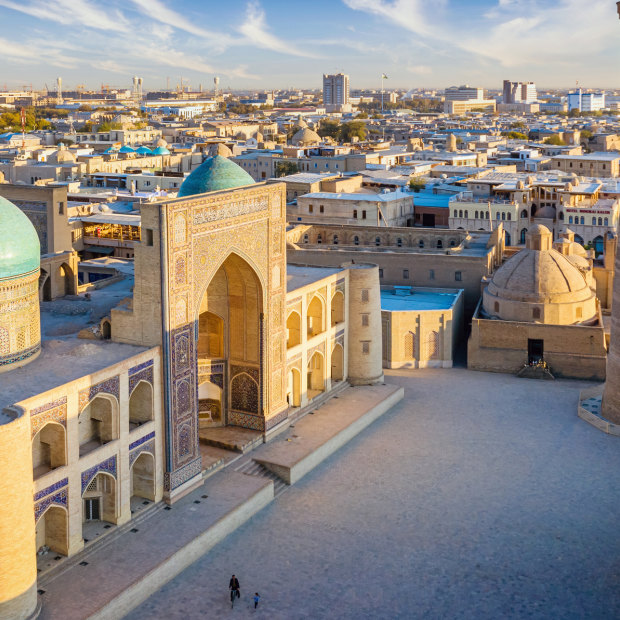
Bukhara’s historic centre is regarded as one of the best-preserved Islamic cities in Central Asia.Credit: Getty Images
When I step off the coach, it’s not the altitude that is taking my breath away – although at 2700 metres above sea level the elevation isn’t exactly insignificant.
Nor is it relief at having emerged from the longest tunnel I’ve ever been through, the five-kilometre Chinese-built Shahristan project. No, it’s the panorama in front of me that has me breathless.
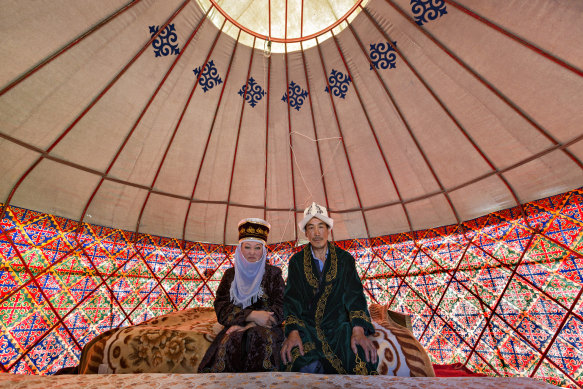
Kyrgyz couple in a nomadic tent known as yurt, near the city of Bishkek, Kyrgyzstan. Credit: Getty Images
Framed by rows of rocky, snow-capped mountains, some standing more than 4400 metres high, Tajikistan’s Maikhura Gorge is stunningly beautiful. Red and yellow poppies, lavender, fennel and mountain sorrel all grow wild here, and these mountains are also home to lynx, brown bear, ibex, wolves – even snow leopards.
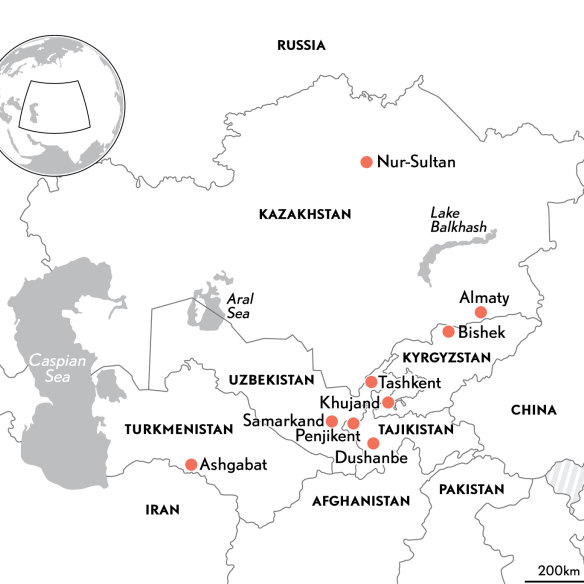
Central Asia … a once daunting destination now made easier.
Today, however, the only animals we see are flocks of Tajikistan’s distinctive fat-bottomed sheep. “We call them Kim Kardashian sheep,” our guide says, straight-faced.
We’re a week into our in-depth, three-week Splendours of Central Asia journey, run by Renaissance Tours, travelling through Tajikistan, Kyrgyzstan and Uzbekistan.
Today’s route takes us from Khujand in the north of the country to the capital, Dushanbe, several hours’ drive south. Like every other day on this tour, it has brought plenty of surprises.
Many of us have long dreamed of exploring the Silk Road – the millennia-old network of trade routes criss-crossing the lands between China and Europe along which everything from silk to slaves, amber to frankincense were transported.
Yet, it’s always seemed like a daunting part of the world to explore. However, thanks to easier flight connections through the Gulf States, high-speed trains and smooth new roads, not to mention more escorted journeys such as the one I’m on, visiting Central Asia is easier than ever.
There is so much to discover. From ancient settlements studded with turquoise-domed mosques and minarets, caravanserai and castles, we follow the paths carved by some of the greatest and most terrible conquerors, everyone from Alexander the Great to Genghis Khan and the area’s last great nomadic conqueror, Timur.
Along the way we encounter buzzing modern cities, verdant valleys, glacial lakes and spectacular mountain ranges with each day bringing a new surprise.
Into the lands of conquest and control
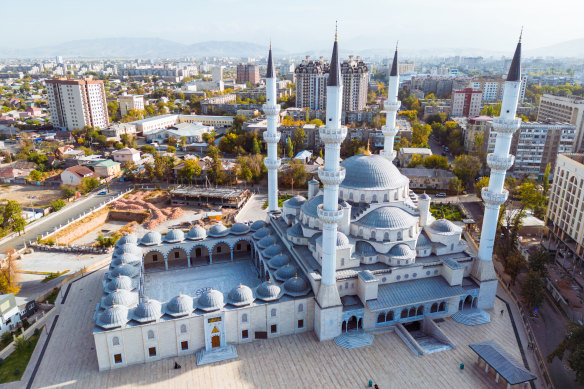
Kyrgyzstan’s leafy capital of Bishkek turns out to be a delight.Credit: iStock
The revelations start on the first day when we land in Bishkek. Few of us have ever heard of the city but Kyrgyzstan’s leafy capital turns out to be a delight: its horizon ringed by snow-capped peaks, its expansive parks dotted with huge plantings of tall, straight-stemmed roses, and its streets lined with welcoming cafes.
In a region where many cities have histories stretching back thousands of years, Bishkek is barely a toddler, with a founding date of 1825. That’s when a fortress was established here by the khanate of Kokand, exerting their control over the area’s trade routes.
Bishkek owes its layout to the forces of the Russian empire, which destroyed the fort in 1860 and eight years later established their own settlement here. It’s not the last time we will come face-to-face with Russia’s long history in the region.
In the Tajik capital of Dushanbe, where the face of the president Emomali Rahmon, often surrounded by flowers, looks down from countless buildings, prettily painted colonial-era Russian buildings still hold their own against a clutch of new Dubai-inspired buildings.
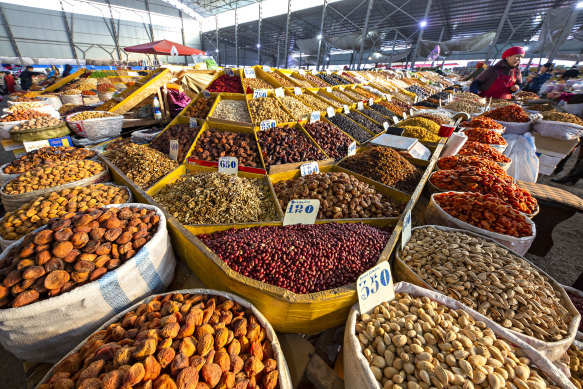
Dried fruits in Osh Bazaar, Bishkek, Kyrgyzstan. Credit: iStock
In the Uzbek capital of Tashkent, it’s a short walk from our hotel to the Kosmonavtlar metro station, where images of Soviet cosmonauts such as Yuri Gagarin and Valentina Tereshkova, the first man and woman in space, decorate the walls. And more than 30 years after the collapse of the Soviet Union, Russian remains the lingua franca.
The Russians are just one in a long series of powers that swept into the area, only to sweep back out again.
Our Renaissance Tours leader, archaeologist and former British Museum curator Iain Shearer, brings these cultures and conquerors to life so vividly that instead of dreading travel-heavy days we actually look forward to them, knowing his fascinating tales mean the hours on the coach will fly by.
Of heavenly horses and lost worlds
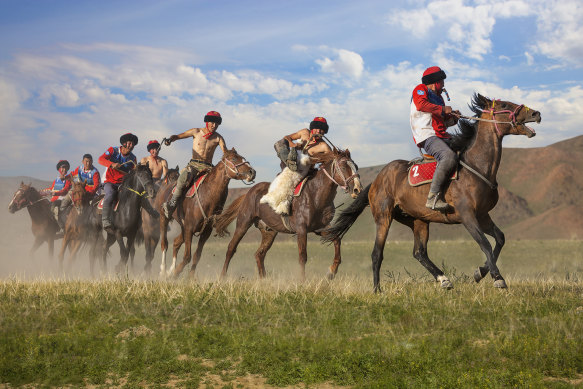
Nomad horse riders play traditional horse game of Buzkashi known also as Kokpar, in Kyrgyzstan.Credit: iStock
Given how many empires have risen and fallen here, I’m surprised at how well local traditions have endured.
Take horses. Shearer tells us how the fleet, hardy horses of Central Asia were so coveted as weapons of war that Emperor Wudi of China’s Han dynasty – faced with regular raids from mounted nomads – sent a military expedition to Central Asia in 103 BC to acquire some horses of their own.
The horses they captured and took back to China became known as the “heavenly horses” and were the basis of a powerful new cavalry.
In Kyrgyzstan’s Chon-Kemin Valley near the Kazakh border, a land of lush meadows flanked by conifer forests, we watch local children play games on horseback. They include kyz-kuumai, or the kissing game, in which a boy and girl race to the finish line – if he gets there first, he can steal a kiss.
They also play kok-boru, where two teams compete to get a goat’s carcass – these days replaced with a weighted 25 kilogram mould – into a goal, tackling each other with the brutality of rugby players. Their ability to stay mounted during violent tussles, plus the horses’ ability to withstand a direct charge and stay on their feet, gives a clue as to how fearsome the nomadic warriors must once have been.
We leave the grasslands behind when we head into Tajikistan. More than 90 per cent of this country is mountainous, with more than half of the terrain above 3000 metres.
Our itinerary takes us to cities such as Khujand, one of the oldest Central Asian cities. It has been known by many names throughout its 2500-year history – from Cyropolis under the Persians and Alexandria Eschate, or Alexandria the furthest, under Alexander the Great, to the Soviet-era moniker, Leninabad.
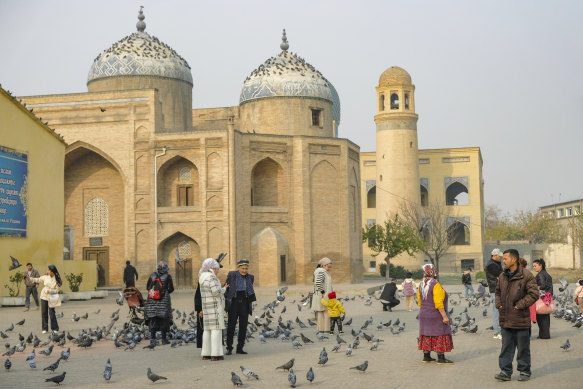
Mausoleum of Sheik Muslihiddin in Khujand, Tajikistan. Credit: iStock
Not every Tajik city has weathered the tides of history as well as Khujand. One of our most memorable stops is at Penjikent, an archaeological site that, without guidance, we may have wandered through in 10 minutes or less. Instead, we take our time and listen enthralled as Shearer recounts the story of the last city of the Persian Sogdian empire to fall to the Arab-led armies that conquered this area in 722 AD.
As we walk through the ruins and then the on-site museum, Shearer shows us evidence of this city’s sophisticated culture – the two- and three-storey merchant houses were decorated with vivid murals – and its cosmopolitan flair, with places of worship for Hindus, Buddhists, Christians and Zoroastrians.
The Sogdians, as with so many other Silk Road civilisations, were merchants. Records from China’s Tang Dynasty describe them as being born with honey on their tongues and honey on their hands – in other words, they knew how to clinch a sale.
Shearer’s account of the fall of Penjikent – a city crammed with refugees fleeing in advance of the Arab-led armies – leaves us shivering. Knowing his city was doomed, the king sent 15,000 civilians out of town, hoping they would find safe haven. Instead, they were overtaken by the invaders, who slaughtered the men and sent the women and children to the slave markets of Damascus.
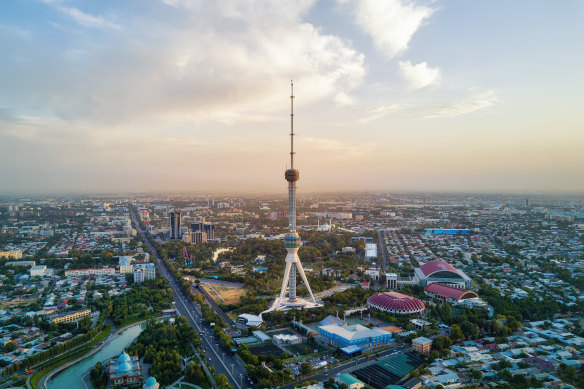
The Uzbek capital of Tashkent.Credit: iStock
The defenders were slaughtered in their turn and the town set ablaze in an inferno so intense that the buildings collapsed in on themselves – which had the one benefit of preserving the astonishing Sogdian murals, rediscovered in the 1940s.
Lest we start thinking of the Persians as the white hats and the Arabs as the black hats, Shearer points out that the armies led by the Arabs actually included many Persian converts who were delighted to swap life in a rigid caste-based society for a religion that preached equality.
From soaring minarets to high-speed trains
Such devastating end-of-empire scenarios are not confined to ancient history. When the Soviet Union collapsed in 1991, none of the Central Asian republics was ready for independence. Economies were devastated, countless lives were ruined. And yet, people struggled through.
It gives us another reason to admire the locals, who have already won our hearts with their uncomplicated friendliness. “They are incredibly resilient,” Shearer says. They are also incredibly hospitable. Central Asia is one of those places where tourists are treated as guests, not walking wallets.
That Central Asian hospitality is displayed when we arrive in the Uzbek city of Kokand one lunchtime. The call to prayer is ringing out and cars are pulling up at the side of the road near the mosque. Its prayer rooms are clearly already full, so later arrivals line up their prayer mats two rows deep on the curb.
Our coach pulls up around the corner in a typical residential neighbourhood, and our local guide points the way through a simple blue door. We step through and then stop, amazed by the sight in front of us.
We have seen plenty of beautiful gardens already on our trip – the Persian tradition of tranquil gardens has left its mark throughout the region, including a surprising number of sprawling city parks – but this verdant oasis is among the loveliest we have seen.
It belongs to a local guesthouse, but today it’s all ours. Beneath leafy fruit trees a long table has been set up, laid out with elaborate bowls bearing all sorts of treats, from juicy apricots and cherries to fresh walnuts and sugar-crusted almonds, salads and bread straight from the oven.
That is just the first course. A typical menu in Central Asia starts with appetisers such as salads, followed by a soup and a hearty main, all accompanied by green or black tea. We spend a leisurely couple of hours working our way through this cornucopia, groaning when platters of sliced melon appear as dessert. We somehow find room for a slice or two.
Lunches like this are especially welcome on the days we spend hours on the road travelling. Distances can be long but local infrastructure – such as those supersized tunnels – is improving (often thanks to Chinese investment).
While most of our travel is done by coach, our itinerary also includes domestic flights and even high-speed train trips.
Uzbekistan’s Spanish-built Afrosiyab high-speed train has long offered reliable connections between the fabled cities of Samarkand, Bukhara and Tashkent – this year, it has been extended to take in Khiva as well.
Where wonders never cease to amaze
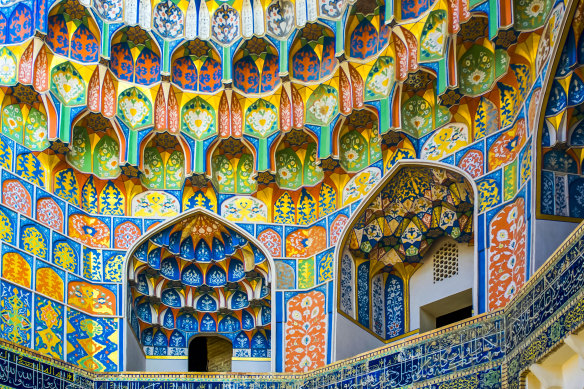
Samarkand owes much of its beauty to Timur.Credit: iStock
Samarkand and Bukhara are the most famous of the Silk Road cities. Built around natural oases that sit at the crossroads of trade routes from China, Afghanistan, India, Iran and the Caucasus, the cities were run by a succession of empires including the Sogdians.
Naturally, the cities were rivals – or as Shearer puts it, “Samarkand and Bukhara are like Sydney and Melbourne, only with a whole lot more blood”.
Samarkand enchants me. The city owes much of its beauty to Timur – known to European contemporaries as Tamerlane – a warlord whose cultural curiosity was exceeded only by his military might and his brutality.
Timur may have left piles of corpses in his wake, but he did have an eye for good architecture. The blue-domed monuments of Registan Square are world-famous and even more splendid when you stand among them.
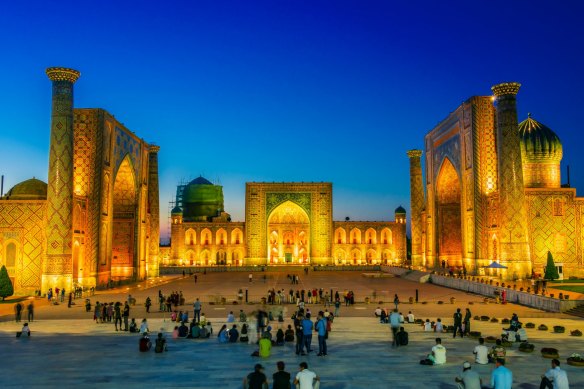
Registan, an old public square in the heart of the ancient city of Samarkand.Credit: iStock
It turns out that Samarkand is home to other equally splendid buildings, including the Bibi-Khanym mosque, which was originally decorated using precious stones carried back from Timur’s victorious campaigns in India. (According to one source, no fewer than 90 captured elephants were required to carry the gemstones back to Central Asia.)
Then there’s the extraordinary Shah-i-Zinda necropolis, a collection of Timurid mausoleums created over eight centuries.
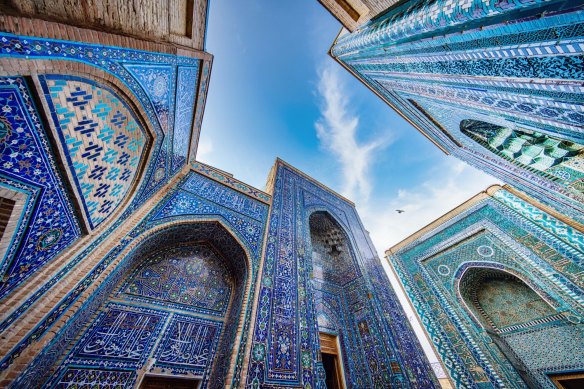
The extraordinary Shah-i-Zinda necropolis is a collection of Timurid mausoleums created over eight centuries.Credit: iStock
Our itinerary includes free time so we can explore at our own pace but even so, there is one place I don’t get around to visiting: the tomb of Daniel, whose story – including the episode in the lion’s den – features in Jewish, Christian and Islamic scriptures. Samarkand is one of several cities that claim to be his final resting place.
According to legend, Timur brought Daniel’s body to Samarkand from its original burial spot in Susa in Iran. It is said the body will keep growing until the day of judgment, which explains why the sarcophagus is a jaw-dropping 18 metres long.
By the time we arrive in Bukhara I have decided I am firmly Team Samarkand. I have no intention of falling for the charms of its rival, even though Bukhara’s historic centre is regarded as one of the best-preserved Islamic cities in Central Asia.
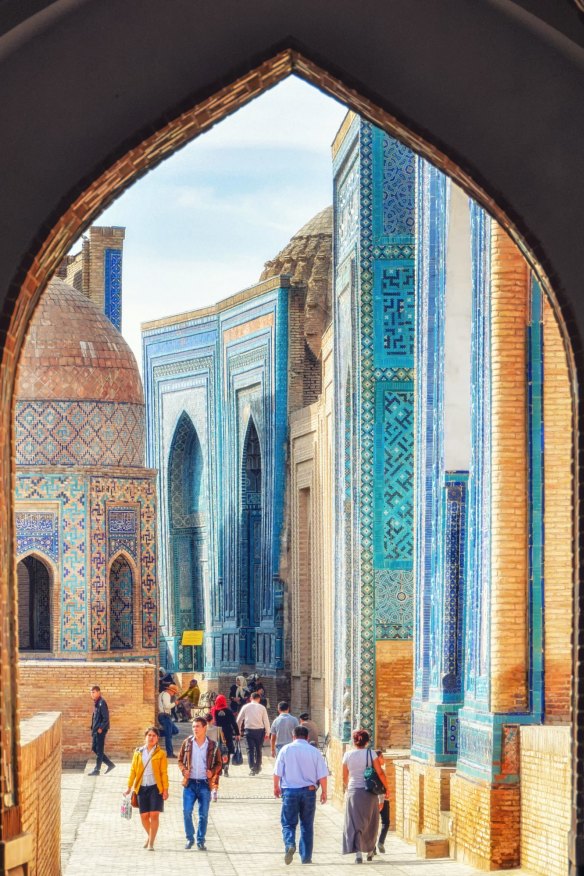
Shah-i-Zinda is an important pilgrimage site for Uzbek muslims. Credit: iStock
The fact that we arrive on a 42-degree day means our first stroll through the historic heart – where al fresco restaurants are arranged around a lake with dancing fountains and where a series of vaulted arcades house an impressive array of traditional craftsmen offering silks, miniatures, carpets and more – makes less of an impression than it may otherwise.
When I return after sunset, however, things feel different. The city’s minarets are beautifully lit, the squares are bustling with cheerful families, and many of my fellow travellers are busy bargaining with the merchants, inheritors of the traditions of the honey-handed Sogdians.
When they proudly show off their purchases the next morning, I realise that the glory of the Silk Road survives not just in its mosques and monuments, but also in the ability to strike a deal.
The writer travelled with the assistance of Renaissance Tours and Qatar Airways.
The details
Tour
The Splendours of Central Asia Tour is part of the World Art Tours series operated by Renaissance Tours and presented in partnership with the Art Gallery of NSW Members. For dates and prices for 2026, contact renaissancetours.com.au
Fly
Qatar Airways, recently named world’s best airline, flies non-stop from Melbourne, Sydney, Brisbane, Adelaide and Perth to Doha, with onward connections to Tashkent. See qatarairways.com
Money
Big hotels are the only places that reliably accept credit cards (mainly Visa – leave your American Express at home). Your best bet is US dollars in small denominations that you can change as needed.
More
visitkyrgyz.com
tourism.tj
uzbekistan.travel
Five more things to see and do in the Stans
Take a hike
Central Asia’s mighty mountain ranges are achingly beautiful. Even if you’re not a hardcore hiker, build in time for a scenic walk.
Hit the bazaar
It’s busy, it’s colourful, and it’s the hub of daily life, so a visit to a bazaar is essential. In contrast to some countries, here you won’t get hit with a hard sell, just a friendly smile (and maybe a free sample).
Get partial to plov
One of the most popular dishes in the Stans is the rice dish plov (like pilaf). Each country claims to have the best. Try it for yourself.
Shop for traditional crafts
From ceramicists who work blindfolded to better feel the quality of their work to fifth-generation silk weavers, this is a place that values craftsmanship.
Be seduced by the cities
Magnificent Silk Road cities like Khiva, Samarkand and Bukhara offer enticing glimpses of this area’s glory days.